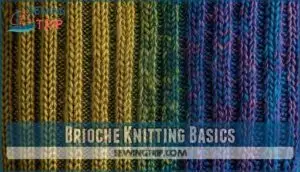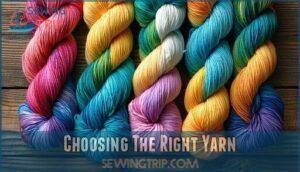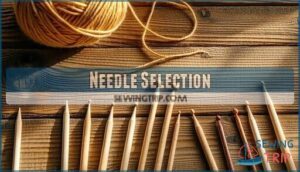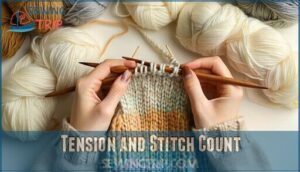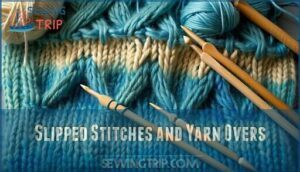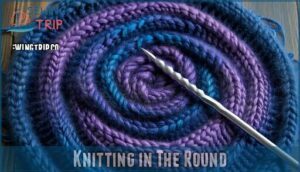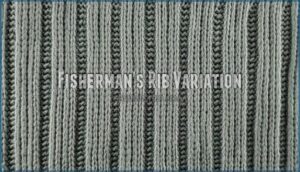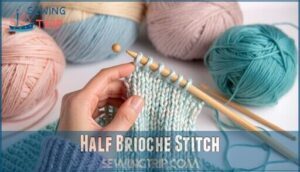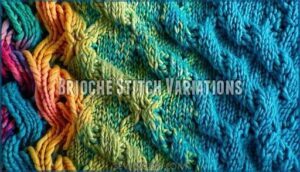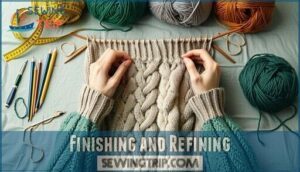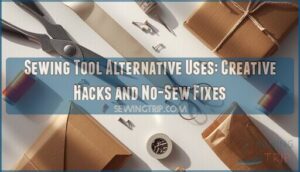This site is supported by our readers. We may earn a commission, at no cost to you, if you purchase through links.
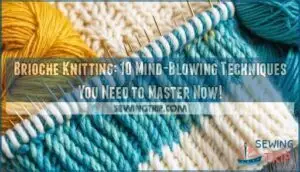
To get started, you’ll master the brioche stitch, which combines yarn overs and slipped stitches for its signature look.
It works beautifully in one or two colors, letting you create bold, standout designs.
Use smooth, elastic yarn and needles with sharp tips for the best results.
Pay attention to tension—it’s easy to miscount with brioche’s airy structure, but mistakes can be a cinch to fix with practice.
Whether you’re aiming for a cozy scarf or intricate sweater, brioche adds elegance and charm effortlessly.
Table Of Contents
Key Takeaways
- You’ll create soft, stretchy, and reversible fabrics using simple brioche techniques like slipped stitches and yarn overs.
- Start with wool or wool blends for grip and elasticity, and use needles 2-3 sizes smaller than the yarn label suggests.
- Mastering tension is key to achieving brioche’s squishy texture; keep it consistent and slightly loose for best results.
- Dive into simple patterns first, then explore advanced options like two-color brioche, syncopated stitches, and waffle textures.
Brioche Knitting Basics
You’ll find brioche knitting surprisingly simple once you understand it’s just a combination of slipped stitches and yarn overs worked together on the return row.
Brioche knitting is simply slipped stitches and yarn overs, creating squishy, stretchy fabric with a luxurious texture on both sides.
This fluffy, reversible technique creates a stretchy fabric that’s perfect for cozy scarves and hats, though you’ll need about 30% more yarn than regular knitting projects.
Brioche Stitch Pattern
While many knitters shy away from brioche stitch pattern because of perceived pattern complexity, it’s actually quite approachable once you understand its basic anatomy.
The brioche stitch creates a luxuriously squishy fabric with distinctive visual texture through a clever combination of slipped stitches and yarn overs.
As you begin, remember to cast on evenly for the ribbed structure.
- Each stitch consists of a slipped stitch paired with a yarn over
- The fabric density is double-sided, making it perfect for cold-weather items
- Your brioche knitting projects will develop a plush, 3D texture after about 8-10 rows
Single-Color Brioche
Single-color brioche creates a heavenly ribbed texture that’s perfect for beginners.
You’ll create this luscious, squishy fabric using only one yarn while mastering the brioche stitch basics.
Cast on an even number of stitches, then follow the simple one-row repeat pattern.
Your patience pays off after 8-10 rows when the stitch definition truly pops.
Remember, proper blocking effects enhance your finished project ideas!
Two-Color Brioche
Ready to level up your brioche knitting? Two-color brioche transforms basic stitches into stunning colorwork with depth and texture.
You’ll work with light and dark yarns, creating intricate motifs where color dominance plays a vital role.
Yarn management might seem tricky at first—juggling two strands simultaneously—but the payoff is worth it! Pattern reading becomes easier as the contrast between colors helps you track your stitches better than single-color projects.
Reversible Designs
One of the most magical aspects of brioche knitting is its reversible nature.
The true enchantment of brioche knitting lies in its reversible beauty, showcasing stunning textures on both sides of your creation.
Unlike standard knitting, both sides of your brioche fabric look equally finished.
This makes it perfect for scarves, cowls, and blankets where both sides might show.
The texture combinations and pattern symmetry remain consistent regardless of which side faces out.
You’ll love how your two-color brioche creates distinct yet complementary designs on each side.
Getting Started
You’ll need an even number of stitches and a grippy yarn like wool to start your brioche knitting journey.
Don’t worry if your first few rows look wonky – it takes about 8-10 rows before that fluffy, squishy texture really starts to show itself.
Casting on Techniques
Now that you understand brioche stitch basics, let’s set your project up for success with the right cast-on methods.
The foundation of your brioche project matters more than you might think.
- Long-Tail Tubular Cast-On creates that perfect stretchy edge brioche knitting demands
- Two-Needle Cast-On offers extra give for comfy cuffs and edges
- Provisional Cast-On works wonders when joining pieces later
- Italian Cast-On produces beautifully elastic edges ideal for scarves
Choosing The Right Yarn
When selecting yarn for brioche knitting, remember that fiber content dramatically affects your stitch definition and overall experience. You’ll need yarn with sufficient grip and elasticity to maintain those beautiful, puffy stitches.
| Yarn Type | Recommended For Brioche | Why It Works | Project Suitability |
|---|---|---|---|
| Wool/Wool Blends | Highly Recommended | Excellent grip and springiness | Scarves, hats, sweaters |
| Natural Fibers | Recommended | Good stitch definition | Most brioche projects |
| Superwash/Synthetic | Not Recommended | Too slippery for yarn overs | Avoid for beginners |
| Cotton/Silk | Use With Caution | Lacks necessary elasticity | Small, simple items only |
For a wide selection, consider browsing options for specialized knitting yarn. Don’t forget – brioche knitting uses nearly twice as much yarn as standard stitches, making yarn selection crucial for a successful project.
Needle Selection
Now that you’ve picked the perfect yarn, let’s talk needles. For brioche knitting, your choice of needles can make or break your project.
Generally, you’ll want to go 2-3 sizes smaller than what your yarn label suggests for tighter stitches. If you’re seeking suitable options, consider durable wooden needles.
- Needle material matters – wooden or bamboo needles grip yarn better, preventing slippage
- Pointed tips help execute yarn overs more precisely
- Circular needles work best for larger brioche projects like scarves
- Consider shorter needle length for smaller projects to maintain control
Tension and Stitch Count
Now that you’ve got your needle size figured out, let’s talk about tension and stitch count in brioche knitting.
Your knitting tension directly affects your brioche stitch definition. Unlike regular knitting, brioche requires consistent, slightly looser tension to accommodate those plush, squishy stitches.
| Tension Type | Impact on Brioche | Recommended For | Effect on Gauge | Fix for Issues |
|---|---|---|---|---|
| Too Tight | Difficult to work | Never | Smaller stitches | Go up needle size |
| Just Right | Perfect stitch definition | Everyone | Matches pattern | No fixes needed |
The table outlines the effects of different tension types on brioche knitting, including the impact on stitch definition, recommended use, effect on gauge, and fixes for common issues.
Brioche Knitting Techniques
You’ll discover that mastering brioche knitting techniques isn’t as hard as it looks once you understand the basic moves of slipped stitches and yarn overs.
With a bit of practice, you can create stunning reversible fabrics that are twice as thick and squishy as regular knitting.
Slipped Stitches and Yarn Overs
Now that you’ve assembled your tools, let’s discover the magic of brioche knitting through its fundamental elements: slipped stitches and yarn overs.
These two techniques create that signature squishy texture you’re aiming for.
- SL1YO mechanics involve slipping a stitch while adding a yarn over in one motion
- Proper tension control prevents loose or tight spots in your fabric texture
- Your yarn over should drape loosely around the needle, not pulled tight
- Each slipped stitch combined with a yarn over creates the characteristic brioche stitch definition
To truly master the technique, explore two-color brioche projects for added complexity, and understand how to apply proper tension control to achieve the desired fabric texture, which is essential for brioche knitting.
Knitting in The Round
Once you’ve mastered flat brioche, knitting in the round opens up a world of seamless projects.
You’ll need circular needles and stitch markers to keep track of your pattern. When joining rounds for a brioche cowl pattern or brioche hat pattern, be extra careful not to twist your stitches.
Spiral brioche creates a continuous flow without seams, making your brioche knitting look professional and polished.
Fisherman’s Rib Variation
While circular knitting creates seamless brioche projects, fisherman’s rib offers an easier execution path to similar results.
You’ll knit into the row below instead of using yarn overs—many knitters find this alternative approach more intuitive.
The finished fabric looks nearly identical to traditional brioche stitch but requires fewer specialized techniques.
Maintain consistent tension for best results, and you’ll still achieve that gorgeous, stretchy rib elasticity that makes brioche knitting so beloved, with its unique characteristics and visual appeal of seamless execution.
Half Brioche Stitch
While Fisherman’s Rib creates a full, squishy texture, Half Brioche Stitch offers a lighter alternative that’s perfect when you want less bulk but similar texture.
This technique alternates between a brioche row and a standard knit row, creating a thinner fabric with unique drape characteristics.
When working with Half Brioche, remember these key points:
- Use larger needles than your yarn suggests
- Maintain consistent tension for even stitches
- Count your rows carefully to maintain the pattern
- Check your fabric’s reversibility factor as you go
Half Brioche is ideal for projects where fabric density matters, like lightweight scarves or summer garments, and it provides a unique texture.
Brioche Stitch Variations
You can transform your brioche knitting projects by learning creative stitch variations that add new textures and designs.
From uneven stitch counts to bold, multidimensional patterns like double or waffle brioche, these techniques keep your knitting fresh and exciting, with creative stitch variations.
Uneven Number of Stitches
Working brioche knitting with an odd number of stitches lets you create symmetrical edges while keeping things interesting.
The two-row repeat offers edge stability and pattern adaptations for scarves or shawls. You’ll enjoy how the brioche stitch still feels balanced, even with this tweak.
Follow a knitting tutorial to explore these design considerations—perfect for creating unique, eye-catching pieces!
Double Brioche Stitch
The double brioche stitch doubles the fabric thickness, making it perfect for cozy projects like blankets or winter accessories.
This advanced variation of brioche knitting amps up the reversibility factor, creating a textured, ribbed surface on both sides.
With enhanced stitch definition and creative color dominance options, it’s a versatile technique. Experimenting with two-color brioche knitting allows for stunning patterns.
Explore a brioche stitch tutorial to discover its project suitability!
Waffle Brioche Stitch
Building on double brioche, the waffle brioche stitch brings depth with its signature waffle texture.
This four-row pattern blends stitch anatomy, pattern design, and clever adaptations.
It’s ambitious-beginner friendly and shines in projects like cozy cowls or baby blankets.
With a brioche stitch tutorial, master this squishy classic and explore endless brioche knitting patterns for textured treasures.
Syncopated Brioche Stitch
Waffle Brioche adds cozy texture, but Syncopated Brioche takes pattern variations up a notch.
By flipping brioche knit and purl stitches, you create dynamic, shifting ribbing.
Pair it with two-color brioche for jaw-dropping colorwork techniques.
Mastering brioche knitting techniques like stitch definition and design applications opens endless possibilities.
Struggling? Troubleshooting syncopation’s reversible quirks makes mastering this brioche stitch variation oh-so-satisfying with dynamic results.
Finishing and Refining
Finishing your brioche project is all about clean edges, stretchy bind-offs, and polished details that make your work shine.
You’ll refine your knitting with techniques like blocking and troubleshooting, ensuring your final piece is both beautiful and durable.
Binding Off Techniques
Binding off brioche knitting keeps your edges flexible and polished.
Go for a Stretchy Bind-Off or try the Tubular Bind-Off for smooth finishes.
Tackle a tricky edge with these tips:
- Use loose tension for elasticity.
- Bind off following brioche decreases.
- Skip yarn overs during binding off.
- Master tension control, avoiding flare.
- Add Decorative Edges for flair!
Selvage Stitches and Edges
Mastering neat edge techniques guarantees your brioche knitting projects look polished.
Use a garter stitch selvage for smooth seaming or a 3-stitch brioche edge for fluffy, symmetrical sides.
Selvage stitches prevent edge distortion and enhance symmetry.
Here’s a quick reference:
| Selvage Type | Best Use | Look |
|---|---|---|
| Garter Stitch Selvage | Seaming | Clean, flat |
| 3-Stitch Brioche Edge | Scarves, blankets | Fluffy, rounded |
| Double Stockinette | Decorative edges | Smooth, professional |
The table provides a summary of the different selvage types, their best uses, and the look they achieve, helping you choose the right edge technique for your project.
Blocking and Care
Blocking and caring for brioche knitting is essential for flawless results.
To keep your project looking sharp, follow these tips:
- Wet Block: Soak gently, then shape.
- Steam Block: Great for quick fixes.
- Wash Gently: Use mild wool detergent.
- To maintain fabric integrity, choose pH-neutral detergents.
- Air Dry Flat: Avoid stretching.
- Store Smartly: Roll or fold loosely.
Your knitting projects deserve this TLC!
Troubleshooting Common Issues
When fixing brioche mistakes, spotting dropped stitches or stitch identification issues early is key.
Uneven tension or yarn management mistakes can cause tension problems and edge curling.
Stay patient—brioche increases, decreases, and pattern mistakes unravel quickly if missed.
Good lighting and careful knitting help.
You can find resources to help fix errors online.
Tackle knitting mistakes by slowing down, keeping consistent tension, and practicing brioche stitch recovery techniques.
Frequently Asked Questions (FAQs)
What is the purpose of brioche knitting?
Brioche knitting creates soft, thick, and stretchy fabrics with a unique ribbed texture.
It’s perfect for cozy scarves, hats, or blankets, giving projects a luxurious feel while being reversible and surprisingly fun to learn.
Is brioche knitting difficult?
Learning brioche knitting is like tackling a puzzle—it looks tricky, but it’s just about following steps.
With practice and patience, you’ll get it.
Start slow, enjoy the process, and you’ll master it soon!
What is the difference between ribbing and brioche stitch?
Ribbing uses basic knit and purl stitches for a stretchy, flat texture.
While brioche adds slipped stitches and yarn overs, creating a squishy, reversible fabric.
Brioche feels more intricate but offers unique depth and fluffiness.
What is the difference between brioche knitting and regular knitting?
Think of regular knitting as a simple melody, while brioche knitting is a rich harmony.
Brioche uses yarn overs and slipped stitches for plush, stretchy textures, while regular knitting follows basic knit and purl rhythms.
What materials are best for brioche knitting?
Use springy yarns like wool or wool blends for elasticity and texture.
Avoid slippery fibers like cotton—they lose shape.
Pick needles 2-3 sizes smaller than usual for tighter stitches and better fabric definition.
What are the advantages of brioche knitting over regular knitting?
Brioche knitting creates a thicker, stretchier, and more textured fabric compared to regular knitting.
It’s reversible and cozy, perfect for winter projects.
Plus, the intricate patterns impress without being as hard as they look!
Is brioche knitting suitable for beginners?
Dipping your toes into brioche knitting might seem tricky, but it’s beginner-friendly with patience.
Its one-row repeat is easy to remember; just master slipping stitches and yarn overs, and you’ll create fluffy, stretchy fabric in no time!
What tips can I use to make brioche knitting easier?
Start with stretchy needles and wool, keeping a loose tension.
Practice slipping stitches and yarn overs until it feels natural. Take breaks often—your hands will thank you!
Stick with simple patterns as you build confidence, and remember to keep a loose tension to make the process easier.
What are some advanced brioche knitting patterns?
Immerse yourself in bold creations with two-color brioche scarves, floral motifs, or waffle textures.
Master syncopated patterns or left-leaning increases.
Each stitch feels like crafting art—a tactile challenge that blends beauty, rhythm, and technical finesse.
How can you create brioche lace designs?
To create brioche lace designs, mix yarn overs, decreases, and slipped stitches.
Alternate between brioche knit (brk) and decreases for lacy patterns.
Use lightweight, smooth yarn for clarity, and watch tension to highlight details.
Conclusion
Imagine brioche knitting as a dance—each loop and yarn over a graceful step creating mesmerizing patterns.
With these 10 techniques, you’ve got everything you need to conquer this art form.
From mastering the basics to tackling eye-catching variations like two-color designs or the syncopated stitch, brioche knitting transforms your projects into functional works of art.
Don’t rush; enjoy the process, fix mistakes with ease, and embrace how this technique makes every stitch worth stitching!

